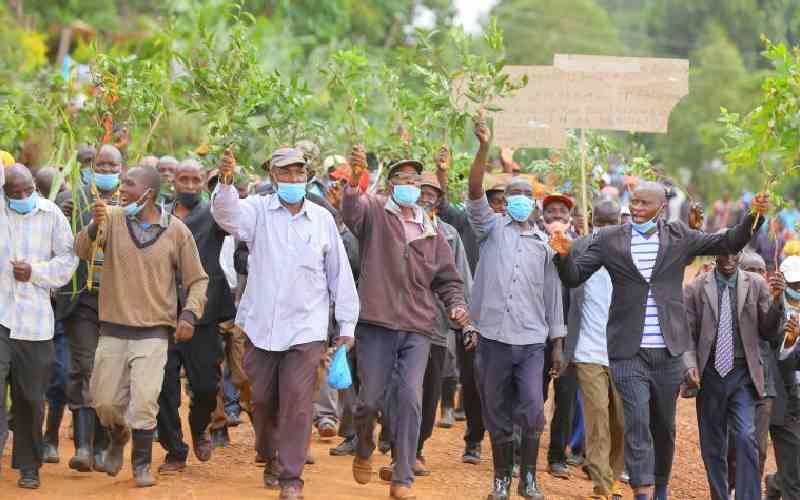By Amos Kareithi
Very few of the 250,000 teachers in the country currently sulking over the possibility of their salaries being slashed for going on strike appreciate how the profession came to be in Kenya.
By rolling back the mat of time, historical records show how the missionaries crafted the policy, which for years shaped education sector in Kenya. Shortly before the white administration formulated the policy to regulate African education, a nondescript school was started in 1917.
This was after a philanthropist; Mukunga wa Njehu donated a portion of land to start a rudimentary elementary school to cater for African children in Githunguri.
Writer, E N Wangamata, sheds some light on this in his book, The Presbyterian Church of East Africa: An Account of Its Gospel Missionary. The author explains that things took a different twist after Njehu later sold his land in 1923, a development that split the community.
Basic education
Two factions emerged where a pioneer teacher Wanyoike wa Kamawe led one group while Musa Ndirangu led the other. The bone of contention was the location of the school, as Ndirangu wanted it relocated at Kanjai, where Wilson Gathuru donated land. However the other faction led by Kamawe, which wanted it at Githunguri, won as the Government ultimately recognised their school.
Kamawe effectively made history by establishing the first independent school in Gikuyu land. The Government was at first duped that this was just a harmless elementary C school but would later realise the residents had very ambitious plans. Around this time in 1919 the Government established Education Commission which proposed that mission schools provide basic literally education for children up to 11 years and then technical education between ages 12 and 18.
The colonial authorities wanted African children exposed to ‘technical education’, which they hoped would create artisans to serve in public and private sectors. The Africans were not impressed by this technical education as they deemed it inferior to the one offered to Europeans.
To Africans, this type of education was aimed at condemning them to a life of servitude, forever breaking their backs for whites. So as to create as many artisans as possible, the Government established a policy of motivating mission schools. To motivate the mission schools churn out as many artisans as were required by the ever-increasing white settlers, the Government crafted a reward scheme. Each mission school was allocated 5 pounds per year for every artisan trained and a further 2 sterling pounds for toolbox per apprentice. However, the Government took over the role played by missionaries in education in 1924 and embarked on a policy of standardising the curriculum. This took place at the time of the enactment of the 1924 Education Ordinance, which allowed the Government to inspect all schools and supervise education as well as registering all schools and teachers.
Relied on mules
Although present day teachers are haranguing the Government for all manner of allowances, things were tough then. Wangamata writes that teachers serving in African schools traversed long distances and at times relied on mules.
Although mules were relatively cheaper, they were still out of reach of the ordinary teacher, whose salary had stagnated for over 10 years. The beasts of burden, cost between 600-700 rupees, and died easily as they were susceptible to diseases.
At the time (1924), the overworked teachers were paid 3.3 dollars, having been increased from 2 dollars in 1913. This was the salary they were paid for the next 10 years. Back to the Independent School, the Government was horrified when a few days before the institution opened its doors a signboard boldly announced it intent. Contrary to what the Government had thought, the signboard board declared that this was going to be a college. The Government was very embarrassed but had no choice since it had given its approval. It had to allow it to operate but on condition.
The caveat was that the school submits itself to regular inspection by the colonial authorities. Later on, when the Government realised that one of the prominent sons of Kiambu District, Mbiyu Koinange was to be the principal, it made an irresistible offer.
Stay informed. Subscribe to our newsletter
Although the Government had flatly declined to employ Koinange despite graduating as the first African with a Masters degree, it now went on the charm offensive. According to Wangamata, the Government now was ready to employ him as a principal with a salary of 120 sterling pounds.
At the time whites serving as principals were drawing a salary of 1,000 sterling pounds. The proposal did not go down well with Koinange who retorted: “When I was studying for my post graduate degree at the United States of America, the university did not halve my tuition fee because of my race. Why should I earn less that whites?” The college was officially opened in January 1939 under the leadership of Koinange amidst a lot of fanfare and expectations.
Although the World War would later erupt and plunge countries around the world in misery, there was optimism in Githunguri. The residents who had been organised into age groups and had been contributing money towards the construction of a college had plans of their own university in the near future. In the meantime, elaborate plans had been made, as Henry Mworia explains in his book, I, The Gikuyu, and the White Fury.
Mworia’s age group was planning to celebrate the momentous occasion of completing paying the money they had been directed to remit by the fundraising committee. Mworia recalls being sent to Nairobi to hire a small plane that would land on the college’s ground to make the day memorable.
He proceeded to Eastleigh where one white man leased out his plane at a fee. Mworia and one of the chairmen of the Githunguri fundraising committee, Dedan Mugo were to fly the plane to Kiambu.
However, when word reached the District Commissioner in Kiambu, things took a nasty turn. The white administrator vowed that no plane would be allowed to fly past the jubilant crowds in Githunguri.
The whites, Mworia writes were annoyed by a song that had suddenly become very popular and was serving as a rallying call. According to the song, the legendary Agikuyu seer Cege Kibiru had prophesied that the completion of Githunguri College would signify that the time for Africans in Kenya to get their freedom was ripe.
This coupled with the establishment of a college disguised as a primary school had made the Government perceive the college in a negative light. After the euphoric opening, things turned sour for the college because complaints of misuse of funds started circulating.
The reports that not all the funds collected had been channelled towards the noble project drove away some prospective donors. Funds dried up and at one point things were so tight that the college closed down.
Mworia contends that there were complaints of misuse of funds, which led to the arrest of some elders who had been collecting money from their clans. By 1940 when the Kikuyu Central Association leaders were arrested, Githunguri College was just a shell as most of the age groups had stopped contributing money.
Closed down
Mworia further argues that the college experienced a sense of rebirth upon the return of Jomo Kenyatta in 1947. Invigorated by his return the elders started contributing money again when Kenyatta returned and took over the leadership of the college as principal.
Although both Kenyatta and Koinange enjoyed a sense of comradeship cultivated when they were both in London, the latter was not happy. There was also subtle resentment by Koinange who had all along taken the college as his own project but had to relinquish its leadership to Kenyatta when he finally returned in 1947.
Perhaps this explains why Koinange left Kenya in 1948 soon after Kenyatta’s return and was not around when Kenya exploded into a rebellion in 1952. Trouble for Githunguri College, Mworia writes can be traced back to rumours of forced oath taking as the 12 age groups were fund raising. This led to the arrest and imprisonment of Dedan Mugo who was the chairman of all the age groups in Githunguri.
When the colonial Government declared a State of emergency in 1952 the college was closed down, and its principal, Kenyatta, arrested.
Suspected Mau Mau adherents were also arrested and the college where residents of Githunguri once hoped to build University of Kenya was transformed into a hanging field. Today, the stone mansions that once accommodated Koinange and Kenyatta, still stand in Githunguri town, indifferent to the passage of time.
Other buildings however were not as lucky for the colonial Government descended on them with vengeance. A corner of the college was turned into a graveyard where suspected Mau Mau adherents convicted of undermining the Government were also hanged in what was once a community college.
[email protected]
 The Standard Group Plc is a
multi-media organization with investments in media platforms spanning newspaper
print operations, television, radio broadcasting, digital and online services. The
Standard Group is recognized as a leading multi-media house in Kenya with a key
influence in matters of national and international interest.
The Standard Group Plc is a
multi-media organization with investments in media platforms spanning newspaper
print operations, television, radio broadcasting, digital and online services. The
Standard Group is recognized as a leading multi-media house in Kenya with a key
influence in matters of national and international interest.
 The Standard Group Plc is a
multi-media organization with investments in media platforms spanning newspaper
print operations, television, radio broadcasting, digital and online services. The
Standard Group is recognized as a leading multi-media house in Kenya with a key
influence in matters of national and international interest.
The Standard Group Plc is a
multi-media organization with investments in media platforms spanning newspaper
print operations, television, radio broadcasting, digital and online services. The
Standard Group is recognized as a leading multi-media house in Kenya with a key
influence in matters of national and international interest.








